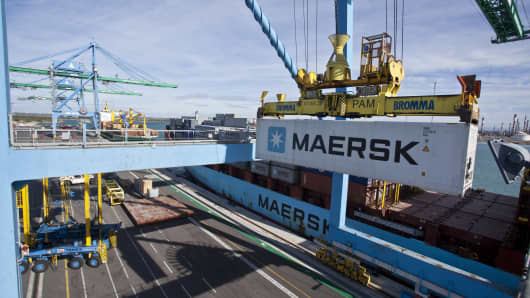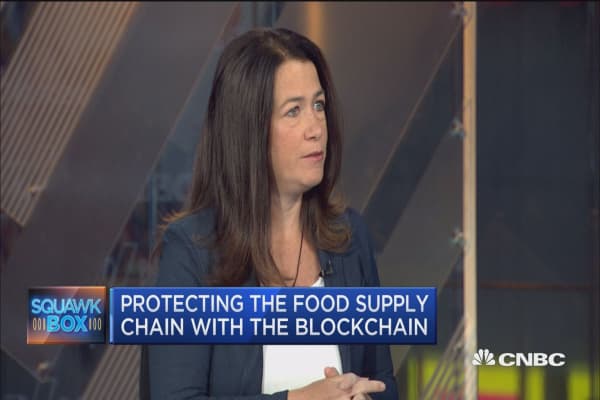MD: Transparency in the “money creation” part of a proper MOE process is crucial to its acceptance, discipline, and efficient and effective operation. Many eyes on the traders making the trading promise and getting them certified … i.e. creating money keeps those traders honest. Many eyes on the traders delivery or the process’ mitigation of defaults is also crucial to the process.Transparency into the trader’s responsible (or irresponsible) trading history is crucial for provision for efficient mitigation of defaults with immediate interest collections. It’s an actuarial process if it is to be fair.The universally shared ledger (enabled by block chain technology) will be enormously helpful to any “real” MOE process. The Bitcoin mechanism is nonsense … but that should not cast a shadow on blockchains … only on the ridiculous Bitcoin mining process to create new blocks. New blocks must be created at zero cost to be employed in a real MOE process.
EY teams with Microsoft, Maersk to use blockchain for marine insurance
- Blockchain will be used to take paper out of the marine insurance equation
MD: A “real” MOE process isn’t so concerned with paper as it is with transparency.
- EY has worked closely with blockchain developer Guardtime
- Microsoft and Maersk are among firms to join the collaboration
CNBC.com
Accounting giant EY said Wednesday that it plans to launch the first blockchain platform for marine insurance, alongside Microsoft, A.P Moller-Maersk and others.
The distributed ledger will be used to capture information about shipments, risk and liability, and to help firms comply with insurance regulations.
MD: I am presuming this distributed ledger is transparent to everyone. That is probably an incorrect presumption. At the very least, it needs to be transparent to all the players.
It will also ensure transparency across an interconnected network of clients, brokers, insurers and other third parties.
EY explained that its decision to secure marine insurance data with blockchain was due to a “complete inefficiency” in the sector.
MD: What makes it so inefficient? How does blockchain make it more efficient? If they have inefficiency problems, they need to fix them first.
“The reason we chose marine (insurance) as the starting point for this sort of market is mainly because of its complete inefficiency,” Shaun Crawford, global insurance leader at EY, told CNBC via phone earlier this week ahead of the announcement.
Crawford said the industry was “over capacity” and that there was “a lot of cost to it.”
MD: I wish he could enumerate the most significant costs.
He added: “It’s facing high administrative burdens of managing and writing claims with a lot of paperwork. All contracts are signed multiple times. They go from ship to ship, port to port, through quite a journey.”
MD: The paperwork could easily be removed without a distributed ledger. Paper doesn’t do anything but impose a requirement for an optical capture of documents for archiving. Most of that is already gone. And if it’s not gone, it needs to go before blockchain can do anything.
Distributed ledgers are groupings of data shared across multiple locations without the need for central administrators and other middle men.
MD: But the real reason is for transparency.
The original blockchain was built to serve as the distributed ledger for bitcoin transactions. But various blockchain experts believe the technology can provide transparency for a multitude of different industries, not just the financial services.
MD: Finally he mentions the operative word: “transparency”. And once they have transparency, they will be all about limiting that transparency.
“We’re not talking about a new currency here, we’re not talking about money. We’re talking about data aggregation,” EY’s Crawford added.
MD: You’re talking about transparency. There may be only two parties and one document in question. That’s not about data aggregation.
Maersk said the blockchain platform would enable the shipping giant to maintain a smoother relationship with the insurance market.
“It is a priority for us to leverage technology to streamline and automate our interaction with the insurance market,” Lars Henneberg, head of risk and insurance at Maersk said in a statement Wednesday.
“Insurance transactions are currently far too tedious and frictional. The distance between risk and capital is simply too far. Blockchain technology has the potential to facilitate the desired development that is long overdue.”
MD: They have lots of issues to resolve before they can apply blockchain to the problem.
Blockchain could benefit wider insurance industry
Marine insurance has traditionally relied on physical contracts being shipped to and fro, from one port to another, in order to be eventually signed, according to EY.
MD: So how does blockchain effect a signature? If blockchain can do that, any electronic medium can do that. Signatures haven’t been a problem for a very long time. And the method for protecting them (i.e. the notary system ) has always been a pitiful joke.
The global research firm has worked closely with software security company Guardtime to develop the blockchain platform.
Guardtime said it expects to roll out blockchain to the wider insurance industry after its initial marine insurance deployment.
MD: Does it have to mine to create its blocks? Does “proof of work” enter the concept as Bitcoin claims it needs to?
“Initially, we focused on marine insurance as it is well-suited to a blockchain solution as it has a complex international ecosystem, with multiple parties, multiple jurisdictions, high transaction volumes and significant levels of reconciliation,” Guardtime CEO Mike Gault told CNBC in an emailed note prior to the announcement.
MD: Not compared to normal internet email it doesn’t. These problems have already been solved. Transparency is the issue. Insulation from forgeries and mitigation is the issue. Insulation from fraud and mitigation is the issue.
“But down the line we expect it to be rolled out across other areas of insurance markets — as there are clearly shared benefits and attributes. In fact, blockchain can be applied to any commercial or specialty line of business with high-value assets.”
MD: This is really pretty silly. It’s kind of like if they were developing an email system and thinking … hey, other industries might use email too? Ridiculous!
Blockchain built on Microsoft Azure
The blockchain solution was built on Microsoft’s cloud platform, Microsoft Azure.
MD: A true blockchain solution is not built on any platform. The ledger is distributed on any platform and on all platforms. It’s no different conceptually than the internet we have been using since the early 1990’s. This is silly. This is like a long long time ago when we got direct access disk drives. We ditched batch processing with zillions of tape mounts and went to real time data acquisition and access. What blockchain does is make all the disk drives transparent simultaneously.
Cloud technology allows firms to store data and software via the internet rather than locally on a hard drive.
MD: So what? They would be stupid to be using cloud technology. The internet already allows them to access their servers from anywhere in the world. Putting those servers in someone elses building does nothing for them.
A proof of concept for EY’s digital ledger was completed in March.
“When we built the proof of concept, we built a prototype on Azure to make sure the whole thing worked and is secure, and now what we’re doing is building it,” EY’s Crawford noted.
MD: They have to be joking!They proved security? You don’t prove security until you put yourself out among the thieves and the murderers … and it’s a continual battle ever after.
“We provide that cloud service which we believe is one of the strongest ones on the market, and that’s why we chose Microsoft to work with.”
MD: With a proper blockchain solution, your need for strength goes down geometrically. That’s what blockchain brings to the party. There are guaranteed to me innumerable instances of every record and they are guaranteed to be identical and authentic. That’s what a shared ledger does.
Guardtime said Microsoft’s cloud offered a secure network on which to build the blockchain.
“For any new system to be implemented it needs to be built using the right model, one that is robust, scalable and can co-exist with existing IT infrastructure or systems,” Guardtime’s Gault said.
MD: Then they aren’t building a blockchain process … they’re building a secure multi-hosting process. We’ve had that for a few decades now.
“That’s what Azure and the cloud technology enables us to do, without comprising performance or flexibility, which is why it was so important to partner with Microsoft.”
Mark Russinovish, chief technology officer at Microsoft Azure, said that blockchain had the potential to be “transformational.”
MD: If that transformation takes place, from this description, Russinovish is out of a job … and Azure goes into the bit bucket. And that will be the case when the obvious becomes apparent to them and everyone else. Blockchain obviates the need for the cloud concept completely. In fact, there never was a need for the cloud concept.
“Microsoft believes blockchain is a transformational technology with the ability to significantly reduce the friction of doing business, especially streamlining business processes shared across multiple organizations,” he said.
He added: “Marine insurance is a prime example of a complex business process that can be optimized with blockchain.”
MD: Looks like they cut and pasted twice. Are they going to say it three times … like they do telephone numbers in advertisements?
Insurers MS Amlin and XL Catlin also collaborated with EY on the project, as well as insurance industry body ACORD (Association for Cooperative Operations Research and Development).
The blockchain solution is set to be implemented from January 2018 onwards.
The race to create large distributed ledger network has become increasingly competitive.
MD: Why? To be truly distributed, it needs to be replicated across multiple competitors. They all have to be on the same playing field.
IBM for instance announced it would partner with food giants like Nestle and Unilever in August, and use blockchain technology to trace the movements of food to avoid tackle contamination faster.
MD: Blockchain doesn’t do that any faster than they can do it right now. In fact, they probably don’t want transparency in that case … but when customers learn such transparency is possible (probably introduced by competitors), they will have to comply … or leave the business. If food can be contaminated, customers want the transparency to see it and protect themselves. They don’t want it hidden from them.
EY told CNBC that its decision to make the announcement ahead of time was due to a host of other players making similar moves.



